 |
|
Green Frog / Eric Dresser |
More and more people are recognizing
wetlands as dynamic, productive and diverse ecosystems. Many
visitors to Great Lakes wetlands immediately appreciate their
natural beauty, experience the sense of tranquility they offer,
and recognize their role in the local landscape. For others,
wetlands are valued for their practical and crucial functions,
such as erosion control and flood regulation. These special
places are wildlife nurseries and nesting sites, feeding grounds
and resting places, water filters and reservoirs. They help
protect shoreline areas from storm damage and attract fish,
birds, amphibians, reptiles and mammals. They are also great
places for people to explore and reconnect with nature.
|
| What defines
a coastal wetland? For most people, there is little
distinction between a swamp and a marsh or a bog. However,
coastal marshes, temperate swamps and northern bogs
are each unique ecosystems that support different species
of plants and animals. All wetland types with a direct
hydrological connection to the Great Lakes are considered
Great Lakes coastal wetlands. |
Unfortunately, wetland values are still not widely recognized.
As a result, during the past two centuries, over two-thirds
of southern Ontario's original wetland area has been lost.
That number reaches 90 percent and higher in areas such as
Ontario's southwest. Wetlands located in coastal areas of
the Great Lakes are especially at risk due to high development
pressure in urban areas, and stresses such as lake-wide water
level regulation. Conservation policies and initiatives now
exist throughout the Great Lakes basin to limit further wetland
losses, and restore lost area and functions. However, conservation
remains an uphill battle as losses continue.
To effectively conserve coastal wetlands, more must be known
about their ecology, location and how they are classified.
In addition, their values must be more widely accepted. Many
wetlands are on privately owned property, affected by thousands
of individual decisions. The Canadian Wildlife Service prepared
this fact sheet to convey the importance of coastal wetlands
in maintaining the hydrological and ecological health of the
Great Lakes ecosystem, and to encourage wider acceptance of
wetland values.

Top
People
need Wetlands
Wetland Functions and Values
Functions and values are
terms often used interchangeably when discussing wetlands.
In fact, they have very different meanings. Functions
include biological, chemical and physical processes that
occur naturally within a wetland, such as nutrient cycling
and ground water recharge. Values, on the other hand,
are an estimate of the worth or importance of wetlands
to humans. Values include recreation, flood control and
water quality improvement. |
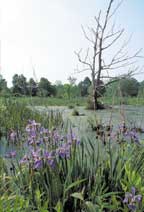
Marsh with wild irises
/ Eric Dresser
|
What Are Wetlands?
Wetlands are lands that are seasonally or permanently
covered by shallow water, or land where the water table
is close to or at the surface. The presence of water
causes the formation of hydric soils and allows the
dominance of water tolerant plant species.
There are four main types of Great Lakes coastal wetlands.
- Swamps are wetlands
dominated by trees and shrubs, with standing water,
limited drainage and often neutral or slightly acidic
soils.
- Marshes are wetlands
that are almost always flooded and are characterized
by a mixture of cattails, reeds and other aquatic
vegetation. Ninety percent of the wetlands located
in Great Lakes coastal areas are marshes.
- Bogs are peat-accumulating
wetlands which trap precipitation as the only water
source, typically have acidic soils and water, and
often contain Sphagnum mosses.
- Fens are peat-accumulating
wetlands with groundwater as the dominant water source,
and support a variety of specialized plant species,
including orchids, sedges and grasses.
|
 |
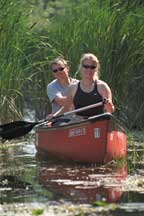 |
Photo:
Lesley Dunn |
Photo:
Matt Young |
|
A selection of functions and values provided by coastal
wetlands
|

|
|

Top
Why are wetlands
where they are?
| Over many years, natural
wetlands develop in the landscape, influenced by two main
factors:
- What is the water source?
- Are adequate soils and sediments present that will provide
the foundation for vegetation growth?
Water works
Without water, there would not be wetlands. Wetlands are
adaptable ecosystems that thrive and depend on changing water
levels and moisture conditions. Some wetlands are inundated
with water year round, while others are flooded only seasonally.
Depending on the source of water, very different wetlands
can develop. Surface water fed wetlands are often nutrient
rich due to runoff from upland forests and agricultural fields.
Groundwater fed wetlands are often nutrient poor, but high
in dissolved minerals. Precipitation fed wetlands are very
nutrient and mineral poor, often preventing them from supporting
lush vegetation communities.
The earth moves under your feet
The second important factor is the presence or absence of
the soils and sediment that support coastal wetland development.
This is largely shaped by local geology and geography. For
example, the hard granite bedrock of the Canadian Shield that
forms much of Lake Superior's shoreline results in far less
erosion and sediment accumulation than softer, sedimentary
rocks found along Lakes Erie and Ontario shorelines. As a
result, features such as sand bars, spits and barrier beaches
protect many wetlands in the lower lakes, while upper Great
Lakes wetlands tend to be more exposed to lake influences
due to less sediment accumulation.
What's in a name?
The term "wetland" is all-inclusive. Addition
of the word "coastal" narrows the scope, however
all coastal wetlands are not the same. Each one has its own
unique set of attributes and resulting functions. Classification
systems are developed to identify and categorize the different
wetland types. Vegetation-based classifications of swamp,
marsh, bog and fen are often not enough to describe differences
between them. Hydrological (water) and geomorphic (land) features
need to be included.
The classification scheme described here is one of several
used throughout the Great Lakes. Within this scheme, there
are three broad systems, each based on the predominant hydrologic
influence on the wetland. Further division within these systems
is also possible and required in many situations.
|
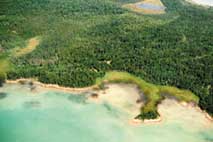 |
Photo:
Ted Cline |
Lacustrine Wetlands
Lacustrine wetlands are
predominantly influenced by lake forces, in protected
bays or on a stretch of open shoreline. This photo and
drawing illustrate open embayment wetlands. An example
of a protected lacustrine wetland is Matchedash Bay on
Georgian Bay. |
 |
|
Photo: Rouge Park Alliance |
Riverine Wetlands
River processes control
these wetlands, at river mouths and along major river
channels. Examples are all wetlands on the St. Lawrence
and St. Clair Rivers, and the many drowned river-mouth
wetlands on Lake Ontario.
Riverine wetlands may be open or protected from the lake.
The photo and drawing depict open drowned river-mouth
wetlands. |
 |
Photo:
Maggie Young |
Barrier-Protected Wetlands
Barrier-protected wetlands
are those that, due to coastal processes, have become
physically separated from the Great Lakes by a barrier
beach or a series of beach ridges. Both lacustrine and
riverine processes may influence these wetlands.
Barrier beach wetlands are connected to the lake through
ground water and/or periodic direct channel flow. Some
barrier beach and other barrier wetlands are also influenced
by the drainage of the wetland's individual watershed.
Many barrier beach wetlands are found around Lake Ontario,
including the one shown here in Prince Edward County,
and Oshawa Second Marsh. |

Top
The rise and
fall of the Great Lakes
Wetlands
need changing water levels to maintain their productivity
and diversity. |
Great Lakes water levels
have been monitored since the mid-1800s, revealing more
than a century of consistent, natural variability. This
data is supported by the historic record contained in
sediments that depicts more than 5,000 years of natural
change. In contrast, human influence has impacted Great
Lakes water levels for a relatively short time. Lakes
Ontario and Superior have been regulated at their outflows
since the mid-1900s to permit consistent shipping and
hydroelectric power production by reducing lake level
variability.
Both natural and human-induced fluctuations impact
a broad range of wetland characteristics, ranging from
water chemistry to plant community composition. Most
often, vegetation is the first wetland component to
be affected. This alteration then changes the fish and
wildlife community.
Water level fluctuations impact not only wetland biology,
but also the many other components that make wetlands
dynamic and productive systems. Currents, wave action,
turbidity, acidity, temperature, and nutrient content
are all affected by changing water levels. For example,
low water levels result in faster warming of wetland
water and may result in unsuitable habitat for certain
fish species. Conversely, high water levels may dilute
nutrient and contaminant concentrations to decrease
local toxicity to plants, fish and other wildlife.
Types of water level fluctuations
and their impacts on coastal wetlands
|
| Type |
Cause |
Magnitude |
Duration |
Impact
on Coast Wetlands |
| Short-term |
Storms,
and wind and atmospheric pressure-driven "tides"
known as seiches. |
0.5
metres
(3 metres has been reported) |
Usually
less than one day |
*
Damage to vegetation due to high winds and waves. |
| Seasonal |
Reflection
of the yearly hydrologic (water) cycle in the Great
Lakes basin. Lowest levels often occur in late summer,
after evaporation has peaked. |
30
to 50 centimetres |
A
few months |
* Unpredictable and variable water levels result
in the highest level of plant diversity. Many plants
and animals are adapted to and depend on a highly
changeable wetland environment.
* Low water levels in the autumn expose wetland
bottom sediments which allow the seeds contained
there (in the seed bank) to germinate.
|
| Multi-year |
Basin-wide,
continental or global climate changes that result
in different patterns of precipitation and evaporation
over a number of years. Also caused by human-induced
water level regulation to facilitate shipping. |
Up
to 2 metres during the 20th century |
More
than one year |
* High water levels can eliminate large areas of
wetland by flooding.
* Low water levels that expose mud flats with an
extensive seed bank will allow wetlands to expand
toward the new lakeshore.
|
Lake
Ontario Water Level Regulation
Lake Ontario's water level has been regulated
since 1960 to facilitate increasing demand for
shipping and hydroelectric power. Unfortunately,
what is good for shipping is not so good for coastal
wetlands. Natural water level variability has
been diminished, thereby reducing the biological
diversity of coastal wetlands that depend on variability
to maintain their vegetation communities.
 |
Photo: Maggie
Young |
Determining the criteria to control regulation
of water level and flow in Lake Ontario and the
St. Lawrence River, is a challenge being addressed
through a binational study launched in 2001 by
the International Joint Commission (IJC). The
five-year IJC study provides a major opportunity
to improve the understanding of past water regulation
impacts on coastal wetlands. The new knowledge
will be used to develop and recommend water level
regulation criteria for the benefit of all interests,
including the specific objective of maintaining
coastal wetland diversity and health.
For more information on the IJC study, visit
www.ijc.org. |
|
|
Wetland flora
Anyone who has explored the natural
shorelines of the Great Lakes has been struck by the diversity of
wetland plants. Cattails, pond-lilies and grasses are plants that
thrive in the wetland environment and represent the traditional
marsh to many people. Wetland plants are classified into categories,
or growth-forms, depending on their ability to grow in water. These
distinctions are general, since most wetland plants – by necessity
– can tolerate a range of water depths. However, there are
four basic growth-forms.
- Floating plants are those that
may be rooted underwater, but whose leaves float on the surface.
These include Yellow Pond Lily (Nuphar
variegatum) and duckweeds.
- Submergent plants are rooted
under the water and grow entirely underwater, for example Wild
Celery (Vallisneria americana)
and Coontail (Ceratophyllum demersum).
- Emergent plants are those species
whose roots might be underwater, but which grow and flower above
the water's surface. The most common examples include Cattail
(Typha sp.) and Bulrush
(Scirpus sp.).
- Wet meadow/shrub plants are
those that grow above the water line where conditions allow. This
area is still influenced by periodic flooded conditions. Plant
types include shrubs, sedges, grasses and other herbs, such as
the Spotted Touch-me-not (Impatiens
capensis), Leatherleaf (Chamaedaphne
calyculata) and Meadowsweet (Spiraea
sp).
Climate, bedrock, land use, and the lake influence vary markedly
around the Great Lakes shoreline. As a result, every coastal wetland
evolves as a unique community of plant species determined by local
physical conditions.
|
Many coastal wetland plants have special habitat
requirements that make them unique, and often hard to find,
such as...
|

Grass Pink / Doug Wilcox
|
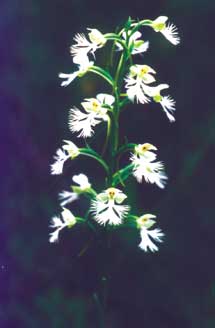
Prairie Fringed Orchid / Canadian
Wildlife Service
|
Other species are much more common...
|

White Water Lily / Eric Dresser
|

Pitcher-Plant / Doug Wilcox
|
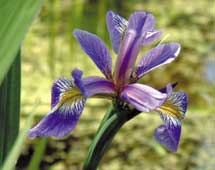
Northern Blue Flag Iris / Kim
Smith
|

Burreed / Brian Branfireun
|

Top
Wetland wildlife
| Beavers
are ecosystem engineers – their dam building activity
is responsible for the creation and maintenance of many inland
wetlands. Similarly, muskrats, which thrive in cattail marshes,
can clear large areas of vegetation for food and to build
their domed shelters. In the process, they increase the amount
of open water. |
THE GREAT LAKES basin is home to hundreds
of birds, mammals, fish, amphibians, reptiles and invertebrates
(see table below), many of which rely on coastal wetlands for all
or part of their life cycle requirements, including Species at Risk
such as King Rail and Fowler's Toad.
Wetlands provide ideal habitats to foster diversity. The habitat
gradient found in coastal wetlands ranges from standing water to
dry land and includes every combination of both. This provides a
wide variety of niches that fulfill the habitat requirements of
many different species. Few ecosystems provide this many opportunities
for different species to live together.
Muskrat |
Wood Duck
pair |
Wood Turtle |
 |
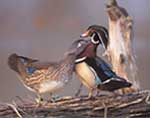 |
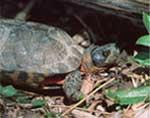 |
Photos:
Eric Dresser |
Many species depend on a mix of open water and emergent vegetation
at a ratio of about one part open water to one part vegetation.
This condition is known as a hemi-marsh. Open water allows birds,
such as Great Blue Heron, a place to hunt, and waterfowl, such as
Mallard, a place to land. Clusters of dense emergent vegetation
provide nesting materials and cover for the eggs and young of many
species. Similarly, most amphibians require a mix of shallow water
and drier upland to complete their life cycle. In their juvenile
stages, frogs, toads and salamanders hatch as water dwelling tadpoles
and efts; however, as they grow, they seek dry land for mating and
feeding requirements.
The unique attributes of wetlands make them home to many Great
Lakes basin Species at Risk that use wetlands for a part of their
life cycles. For example, two rare wetland amphibians – Blanchard's
Cricket Frog and Fowler's Toad – are considered to be endangered
and threatened respectively. Blanchard's Cricket Frog is at the
northern edge of its range in southern Canada and has only been
found at Point Pelee National Park (last observed in 1920) and Pelee
Island (last observed in 1977). Fowler's Toad, also rarely seen
in Canadian Great Lakes wetlands, is found only in isolated areas
around Lake Erie.
The who's
and why's of wetland wildlife |
| Wildlife
group |
Number
of species found in Great Lakes wetlands |
This
group of wildlife uses coastal wetlands for... |
Common
species found in coastal wetlands |
Examples
of Species at Risk that depend on wetlands |
| Bird |
over
100 |
nesting,
breeding, feeding, migratory stopover |
Red-winged
Blackbird, Great Blue Heron |
King
Rail, Least Bittern |
| Amphibian |
13 |
nesting
and feeding, egg-laying, provide food for species higher on
the food chain |
Bullfrog,
Spring Peeper, Northern Leopard Frog |
Fowler's
Toad, Blanchard's Cricket Frog |
| Reptile |
approximately
12 |
breeding,
feeding, basking |
Snapping
Turtle, Eastern Garter Snake |
Eastern
Spiny Softshell Turtle |
| Fish |
100
native Great Lakes fish, many use wetlands |
spawning,
feeding, overwintering nursery habitat, cover from predators |
Northern
Pike, Walleye, Large-mouth Bass |
Spotted
Gar, Deepwater Sculpin |
| Invertebrate |
hundreds |
all
aspects of life, provide food for all other levels of the food
chain |
Crayfish,
Unionid Mussels, Diporeia hoyi |
Wavy-rayed
Lampmussel |
| Mammal |
approximately
12 |
feeding,
cover, shelter |
Beaver,
Mink, Moose |
American
Badger |

Top
Population Decline
As shown in Figure 1 (below),
preliminary data from basin-wide monitoring programs depict the
population declines (and growth) that many species of marsh birds
and amphibians are experiencing throughout the Great Lakes basin.
There are many reasons for the declines – the most ongoing
and detrimental being loss of habitat. For amphibians and many birds,
a loss of wetlands is a loss of their food and shelter, as well
as vital sites for nesting and hibernation. Draining and filling
of wetlands and removal of shoreline vegetation and tree cover is
a major threat to wetland integrity, and hence the wildlife that
depend on them.
A reduction in the quality of wetland habitat through direct and
indirect nutrient and contaminant pollution also impacts wildlife.
The presence of high levels of some pollutants in the food chain,
such as organochlorine compounds, increases the risk of effects
in wildlife such as egg shell thinning, reproductive failure, and
congenital deformities.
Population decreases seen in some species of migratory waterfowl
and other wetland birds can often be attributed to diminished habitat
quantity and quality in overwintering habitats in the southern United
States, Mexico and Central America. Continental agreements such
as the North American Bird Conservation Initiative (see page 10)
are designed to minimize destruction of migratory bird habitat in
all parts of North America.
Comparison of trends in wetland stresses and species population
numbers may reveal direct linkages between a specific stress and
population decline. For example, many birds depend on a specific
mix of emergent vegetation and open water habitats that usually
results from periodic, wide fluctuations in water levels. Long-term
reduction of water level extremes, particularly for Lake Ontario,
may be playing a role in diminishing habitat diversity and thus
the size of these bird populations.
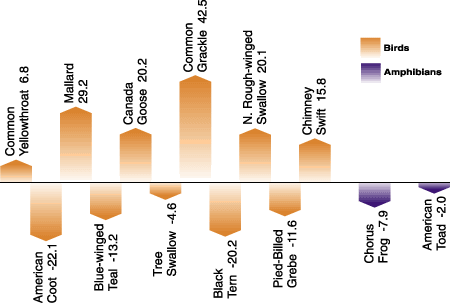
Figure 1. Bird and amphibian populations
that showed significant positive or negative trends throughout the
Great Lakes basin between 1995 and 1999. Percentages indicate the
increase or decrease in population index over that time period.
The Marsh Monitoring Program
The Marsh Monitoring Program (MMP) is a key wildlife monitoring
program for coastal and inland marshes in the Great Lakes
basin, and its success has been fuelled by the energy and
heart of volunteers. Established in 1995, the MMP is a volunteer-based
binational program, coordinated by Bird Studies Canada in
partnership with Environment Canada and the U.S. Environmental
Protection Agency, that conducts regular surveys for marsh
birds, frogs and toads. More than 500 volunteers have taken
part in the survey, contributing more than 6,000 hours of
their collective time. The survey information has already
identified several significant trends, including the significant
decline of Black Tern populations in Great Lakes coastal wetlands.
All of the bird and amphibian trends presented on these pages
originated from MMP data.
The MMP is always looking for new volunteers to monitor their
local Great Lakes marsh. To learn more about this important
and innovative program, visit their website at www.bsc-eoc.org/mmpmain.html
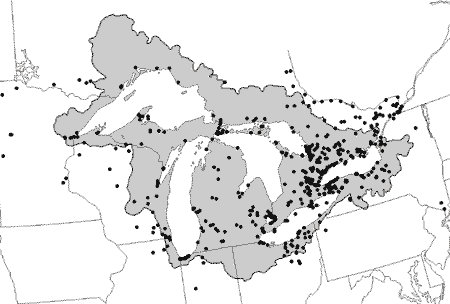
Marsh Monitoring Program
routes 1994-2001
|
Strength in Numbers
 |
A
worm, lumbriculidae, and an amphipod, Diporeia, swimming
at the sediment surface. / NOAA, Great Lakes Environmental
search Laboratory |
As the most diverse group of coastal wetland creatures, invertebrates
(animals without backbones) are excellent indicators of coastal
wetland health since they occupy a wide range of microhabitats
and are relatively easy to collect and study. For example,
the presence of certain dragonflies, damselflies and mayflies
is often an indicator of a healthy and productive emergent
plant community.
|

Top
Wetland stresses
Wetlands are under stress at all times,
from naturally occurring phenomena, such as storms, to human disturbances,
such as draining and filling. Wetlands benefit from some degree
of stress. For example, water level fluctuation can lead to increased
diversity of plant communities. On the other hand, many stresses
are detrimental to wetland area and functions.
Stresses can be direct or indirect. Direct stresses, such as draining
and filling, originate in the wetland itself and are therefore easy
to pinpoint. The causes of indirect stresses are often physically
removed from a wetland. Indirect stresses include urban and agricultural
runoff, and acid rain, which are difficult to control due to their
diffuse and variable sources.
Indicators are an excellent way to assess the level of stress in
different areas and to track improvement or deterioration. Binational
(Canada-United States) Great Lakes programs are working towards
implementing standardized monitoring systems for Great Lakes wetlands
indicators. The State of the Lakes Ecosystem Conference (SOLEC)
is a biennial conference hosted by Environment Canada and the United
States Environmental Protection Agency that provides independent
reporting on the state of health of the Great Lakes basin ecosystem.
In addition, the Great Lakes Wetlands Consortium is a group of wetland
scientists and policy makers dedicated to monitoring the condition
of Great Lakes coastal wetlands. This effort involves validating
indicators and developing methodology to assess the ecological integrity
of Great Lakes coastal wetlands. For more information, visit the
SOLEC (www.on.ec.gc.ca/solec)
and Great Lakes Wetlands Consortium (www.glc.org)
websites.
 |
Figure
2. Stresses that impact Great Lakes coastal wetlands. Photos
(clockwise from top): D.Jude, Carlter Haar, Randall McCune,
Parks Canada, U.S. National Parks Service, John Mitchell.
Centre photo: Eric Dresser. |
Climate Variability and Change
Global climate variability could have a major impact on Great
Lakes coastal wetlands. Global climate models predict that
temperature changes will likely create atmospheric and hydrologic
conditions that will significantly impact the levels of the
Great Lakes. While estimates vary, some studies show that
lake levels may drop from between 0.4 metres in Lake Superior
to 1.0 metre in Lakes Huron and Michigan.
Great Lakes coastal wetlands are especially vulnerable to
any fluctuation in water levels. The rate of the water level
change, the magnitude of the change, the presence of a healthy
seed bank, and the offshore slope of individual wetlands will
determine the impact of such a change on the diversity and
area of wetland vegetation.
Any change in wetland vegetation will have an impact on the
fish and wildlife that depend on wetlands. Reduction in the
proportion of open water in wetlands and an increase in dense
emergent and wet meadow vegetation mean a loss of optimum
habitat for some species of fish, waterfowl, and other marsh
birds.
Despite an uncertain climatic future, coastal wetlands are
resilient and stress-tolerant systems. Given the right combination
of space to move, adequate timing and species adaptation,
Great Lakes coastal wetlands will survive well into the 22nd
century.
Visit www.great-lakes.net/envt/refs/cchange
for more information. |

Top
Conservation of Great
Lakes Coastal Wetlands
Wetland conservation is a challenging
and dynamic goal of individuals and organizations working with wetlands.
Conservation is very broad and includes the collective contributions
of wetland rehabilitation, creation and securement initiatives.
Partnerships are an essential piece of the conservation puzzle.
Through coordinated efforts, governments, non-governmental organizations
and communities work together to rehabilitate and secure Great Lakes
coastal wetlands.
Over 18,000 hectares
of wetland have been rehabilitated (12,800 hectares) and secured
(5,300 hectares) throughout the Great Lakes Basin. |
Wetland conservation is carried out through many important mechanisms,
each essential to lasting conservation. These include:
- Legislation, such as the federal Fisheries Act;
- Policies, including the Canadian Federal Government Policy on
Wetlands Conservation;
- Agreements and treaties, such as the International Ramsar Convention
on Wetlands and the Canada - United States Great Lakes Water Quality
Agreement which called for the development of Remedial Action
Plans (RAPs) and Lakewide Management Plans (LaMPs) to restore
the ecological integrity of the Great Lakes;
- Landowner stewardship efforts, such as donation of ecologically
sensitive land through the federal Ecological Gifts Program; and,
- Volunteer efforts, such as participation in the Marsh Monitoring
Program.
The Great Lakes Wetlands Conservation
Action Plan (GLWCAP)
GLWCAP was developed as the implementation mechanism of the
25-year Strategic Plan for Wetlands of the Great Lakes Basin.
GLWCAP is a series of five-year plans, each with a set of
goals that the partners aim to accomplish. The plan is implemented
through a collaboration among wetland scientists and conservationists
from Environment Canada, the Ontario Ministry of Natural Resources,
Ducks Unlimited Canada, the Federation of Ontario Naturalists,
and the Nature Conservancy of Canada. GLWCAP adopted eight
strategies to work towards its goal of protecting the area
and function of wetland habitat in the Great Lakes basin:
1. Increase public awareness and commitment to protecting
wetlands;
2. Improve wetland science, data and monitoring;
3. Secure wetlands;
4. Create, reclaim, rehabilitate and manage wetlands;
5. Strengthen legislation, policies, agreements and compliance;
6. Strengthen local planning and commitment to protecting
wetlands;
7. Improve coordination and planning among government and
non-governmental organizations; and,
8. Evaluate the program.
The first five-year GLWCAP boasts much success in furthering
Great Lakes wetlands conservation (see map). In 2002, the
second GLWCAP is well into planning stages and beginning implementation.
The focus of this plan will include increasing research on
emerging wetland issues such as climate change and water level
regulation, and maintaining the success rate of wetland rehabilitation
and securement for which GLWCAP has become known.
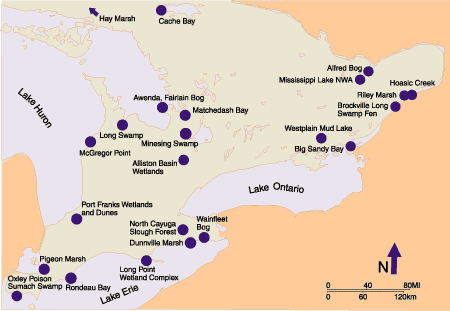
Map 1. Wetland securement
projects (1994 - 2001). The securement of these areas is
thanks to the partners of the Great Lakes Wetlands Conservation
Action Plan and the Eastern Habitat Joint Venture.
|

Top
Partnerships for Conservation Success
With limited funding to go around,
taking advantage of partnerships is essential for success.
- Volunteers provide much needed
labour for planting and monitoring projects. To get involved,
visit www.on.ec.gc.ca/wildlife/newsletters/watchers03-projects-e.html.
- Local groups are often the most
familiar with the history of their wetlands and can provide monitoring
expertise and insight to the potential future uses of a newly
rehabilitated wetland.
- With private landowners controlling
much of the shoreline of the Great Lakes, their cooperation through
donation of land, allowing rehabilitation efforts on their property,
or personal stewardship efforts makes conservation possible.
- University research often uncovers
new insights into the intricate dynamics of local wetlands, which
can better direct rehabilitation efforts.
- Elementary and high school groups
across the Great Lakes basin are involved in planting wetland
vegetation, and even grow some of the seedlings in their own class
rooms.
Many wetlands
remain through vigilant stewardship efforts by local groups
and individuals. |
National Wildlife Areas
 |
Long
Point / Tim Hagen |
The Canadian Wildlife Service owns and manages a network
of 48 National Wildlife Areas (NWAs) across Canada.
They contain a wide diversity of habitat of both national
and even international importance. NWAs protect and
manage critical habitat, including wetlands, for migratory
birds and other wildlife, provide sites for public education
and research and, in most cases, provide for limited
public use. In Ontario, there are 10 NWAs, all in the
Great Lakes basin, with seven located in association
with the Great Lakes shorelines. These range in size
from 0.8 hectares (Scotch Bonnet Island NWA in Lake
Ontario offshore from Prince Edward County) to 3,250
hectares (Long Point NWA located on the north shore
of Lake Erie).
For more information on National Wildlife Areas, and
the NWAs located in Ontario, please visit
http://www.cws-scf.ec.gc.ca/habitat/nwa_on_e.cfm.
|
|
|
Eastern
Habitat Joint Venture
The North American Waterfowl Management Plan (NAWMP) was
initiated in 1986 by the governments of Canada and the United
States in response to serious declines in waterfowl numbers
and wetland habitat losses. Mexico became a signatory to the
plan in 1994, making NAWMP a truly continental conservation
effort. The Eastern Habitat Joint Venture (EHJV) is one of
14 habitat 'joint ventures' established across the continent
under the auspices of NAWMP. In Ontario, the EHJV is a partnership
of the federal government, the provincial government, Ducks
Unlimited Canada, the Nature Conservancy of Canada, and Wildlife
Habitat Canada.
Some programs are applied on a broad scale to influence land
use policies and promote ecologically sound and sustainable
land use practices. Other programs are tailored to secure,
create, restore or rehabilitate balanced habitat conditions
for waterfowl and other wetland wildlife. Since NAWMP's inception
in 1986, Ontario's EHJV partners have legally secured/protected
roughly 115,000 hectares of wetlands (and adjacent uplands)
in the Great Lakes-St. Lawrence region.
For more information on NAWMP and the EHJV visit www.nawmp.ca.
Ecological Gifts Program
Many private and corporate landowners have conserved wetlands
by donating them to government and non-government conservation
organizations. Other landowners have placed land use restrictions
on the title of their property by donating conservation easements.
The Ecological Gifts Program of Environment Canada recognizes
such efforts – by certifying their land donations as
ecological gifts donors can receive enhanced income tax benefits.
To date, over half of all ecological gifts in Ontario (57
of 91 gifts) protect wetland habitat. For more information
visit the Ecological Gifts website at www.on.ec.gc.ca/ecogifts.
North American Bird Conservation Initiative

Virginia Rail /
Eric Dresser
|
Conservation efforts for waterbirds
are now to be coordinated in a North American framework.
Because of its mandate to conserve migratory birds, the
Canadian Wildlife Service has played a primary role in
the development of the North American Bird Conservation
Initiative (NABCI). This coordinated effort among Canada,
|
the United States and Mexico has as its goal to maintain
the diversity and abundance of all North American birds.
This strategy is essential to waterbird success since
many species rely on wetland habitat not only in Canada,
but throughout the continent.
NABCI seeks to coordinate conservation efforts for shorebirds,
landbirds, waterfowl and waterbirds. Many species within
each of these four groups of birds rely on wetlands to
fulfill a part of their life cycles. For more information,
visit www.nabci.org.
|
Lakewide Management Plans
The Governments of Canada and the United States, along with
provincial, state, and municipal governments, and non-governmental
organizations, have come together to ecologically restore
each of the five Great Lakes. The 1987 Protocol to the Great
Lakes Water Quality Agreement called for Lakewide Management
Plans (LaMPs) to "embody a systematic and comprehensive
ecosystem approach to resorting and protecting beneficial
uses".
There are currently four LaMPs in progress – in Lakes
Ontario, Erie, Superior, and Michigan. Conservation and rehabilitation
of wetlands is integral to the work of the LaMPs to improve
degraded fish and wildlife populations and restore lost fish
and wildlife habitat. For more information, visit www.on.ec.gc.ca/glimr/program-LaMPs.html.
|

Top
Wetland rehabilitation
Protection of the functions and values
of coastal wetlands that sbenefit humans every day is frequently
challenged by the many stresses imposed upon these resilient ecosystems.
In response to this decades-old conflict between conserving and
developing wetlands, governments, community groups and non-governmental
organizations around the basin are taking action to rehabilitate
Great Lakes coastal wetlands.
It is not only
important that a rehabilitated wetland looks like a wetland,
it must also function as one. |
Think first...
Successful rehabilitation depends upon a great deal of conceptual
planning, research and design flexibility. There are many things
to consider, including:
- the position of the wetland in the surrounding watershed;
- the presence and/or quality of a seedbank, or a natural source
in the area that allows for recolonization of vegetation;
- the connection between the wetland and the regional water table;
- the underlying sediment; and,
- the need for water level variability to maintain new wetland
vegetation communities.
...and act later
After an often lengthy planning stage, there is much to be done
on the ground (and in the water). Rehabilitation must frequently
address different problems in one wetland.
- Hydrological rehabilitation
may encompass re-establishing natural water level variability
through the use of dykes or creating new channels for directing
water through the wetland.
- Biological rehabilitation includes
altering existing habitat to encourage the settlement of desirable
plants and animals. For example, increasing the ratio of open
water to vegetation will increase overall plant diversity and
satisfy habitat requirements for the most diverse number of species.
Further, by controlling undesirable exotic species such as Purple
Loosestrife, more beneficial species are able to thrive.
- Sometimes an excess of nutrients or toxic contaminants impedes
a wetland's ability to regenerate. The most effective means of
chemical or contaminant rehabilitation
involves reduction at the source, such as decreasing fertilizer
application to agricultural lands or reducing discharge from a
sewage treatment plant. In cases where a point source cannot be
located, rehabilitation in the wetland is required. This is referred
to as in situ rehabilitation and includes
controlled processes such as capping or carefully removing contaminated
sediments.
A second chance for Second Marsh
A natural haven in the city, Oshawa Second Marsh is the largest
remaining coastal wetland in the Greater Toronto Area and
is home to a wide diversity of birds, amphibians and mammals.
Since the early 1970s, human activities have caused significant
degradation of this provincially significant cattail marsh.
Alteration of the natural barrier-beach and water level regulation
had caused a dramatic decrease in wetland vegetation and wildlife
diversity.
In response to this degradation, the last decade has seen
a regeneration of Second Marsh, spurred by the action of the
City of Oshawa, industry, local groups, volunteers, non-governmental
organizations and government partners. Cooperation, in combination
with Environment Canada funding through programs such as Great
Lakes Sustainability Fund and EcoAction, has allowed the re-establishment
of natural hydrological connection to the lake, re-establishment
of emergent vegetation, and protection from carp (often destructive
to vegetation) entering the wetland. Future projects include
the creation of a water control system that allows management
of wetland water levels in a manner reflective of natural
processes. This will promote long-term sustainability of the
wetland's rehabilitation.
For more information, visit: www.secondmarsh.com,
sustainabilityfund.gc.ca,
www.ec.gc.ca/ecoaction

Oshawa Second Marsh /
Joel Ingram
|
|

Common Yellowthroat /
Eric Dresser
|
|
Rehabilitation
Vocabulary
- Rehabilitation –
Improvement of the functions or values of a degraded wetland.
- Restoration – Modification
of the existing function and structure of a wetland's habitat
so that it is similar to historical conditions.
- Creation –The conversion
of a persistent upland vegetation community or ephemeral
shallow water area into a permanent wetland where no previous
wetland existed.
- Enhancement – Activity
that addresses wetland stresses or limitations in order
to improve one or more wetland functions or values.
|

Top
What does the future hold?
| Great
Lakes coastal wetland science and conservation have come
a long way. The ecological, social and economic values of wetlands
are gaining widespread recognition across Canada by the public
and governments alike. At the same time, researchers are uncovering
new insights into the complex, interwoven nature of wetland
hydrology and ecology. |

Photo: Glenn Barrett
|
Moreover,government funding, programs and guidelines are contributing
to the conservation and rehabilitation of wetlands throughout
the Great Lakes basin. |
Science and monitoring play a critical role in the development
and implementation of environmental policy in Canada. Further, wetlands
and the functions they provide cross an increasing number of statutes,
policies and programs delivered by Environment Canada. To address
this growing requirement, the Canadian Wildlife Service of Environment
Canada is expanding its wetland science and monitoring capacity
through active participation in binational programs such as the
Great Lakes Wetlands Consortium, the IJC Lake Ontario - St. Lawrence
River Study and SOLEC. While the many values and functions of wetlands
are increasingly clear, the difficulty often encountered by wetland
scientists and conservationists is in communicating these functions
and values in a way that will be understood and appreciated by landowners,
governments and the public.
At Point Pelee
on Lake Erie, the area's wetlands were found to have an annual
recreational value of more than four million dollars, thanks
in large part to the birdwatchers who flock to this famous
avian migratory stop-over. |
One of the most common ways of demonstrating the value of something
is by quoting a price. But what is the price of a wetland? Our ability
to answer and publicize the results of this question is becoming
one of the key mechanisms to enlist support for wetlands conservation.
An entire branch of economics has emerged that is devoted to the
assessment of ecological value. Another Great Lakes Fact Sheet,
Putting an Economic Value on Wetlands - Concepts, Methods and Considerations,
describes in detail many of the methods and considerations involved
in valuing wetlands. It can be found at www.on.ec.gc.ca/wildlife/publications-e.html.
Despite the many advances and increased awareness, coastal wetland
losses continue. These losses highlight that there is more that
can, and should be done to increase our understanding and protection
of Great Lakes coastal wetlands. Now and in the future, multi-partner
coordination will help to avoid duplication of research, and take
advantage of the breadth of knowledge held by wetlands scientists
in all Great Lakes jurisdictions. This cooperation will improve
conservation and rehabilitation efforts in Great Lakes coastal wetlands,
efforts that support the countless wetland functions and values
upon which humans, fish and wildlife rely.
| General Educational Themes
| Wetlands |
Biology and Wildlife |
Chemical Contaminants in the
Great Lakes |
Endangered Species in Ontario |
| Habitats and Communities |
Human-Environment Interactions |
| Interactions Within Ecosystems |
Water Systems |
Great Lakes Fact Sheets
The Great Lakes Fact Sheet
series is available on-line at the following URL: www.on.ec.gc.ca.
All publications are available in both HTML and PDF formats.
To order printed
copies of this or any other Great Lakes Fact Sheet, contact:
|
| |
Environment Canada
Canadian Wildlife Service (Ontario Region)
4905 Dufferin Street
Downsview, Ontario; M3H 5T4
Tel: 416 739-5830; Fax: 416 739-5845;
E-mail: Wildlife.Ontario@ec.gc.ca
|
| Prepared by: Maggie Young, Nancy Patterson,
Lesley Dunn.
Background photos: Eric Dresser; except page 2 (top)
photo: Great Lakes Sustainability Fund.
Thanks to: Bird Studies Canada, Douglas A. Wilcox,
Dennis Albert, Joel Ingram, Todd Thompson and Gary McCullough
for their contributions.
This fact sheet was printed on 20 percent recycled
paper, and printed with vegetable-based inks.
Published by Authority of the Minister of the Environment
© Minister of Public Works and Government Services
Canada, 2002
Catalogue No. En 40-222/11-2002E; ISBN 0-662-31654-1
Aussi disponible en français. |
About the Canadian Wildlife Service
The Canadian Wildlife Service of Environment Canada manages
wildlife matters that are the responsibility of the federal
government. These include protection and management of migratory
birds, nationally significant habitat and endangered species,
as well as work on other wildlife issues of national and international
importance. In addition, the Canadian Wildlife Service does
research in many fields of wildlife biology. In 1997, the
Canadian Wildlife Service (formerly the Dominion Wildlife
Service) celebrated its fiftieth year.
Visit the Canadian Wildlife Service Wetlands website! www.on.ec.gc.ca/wetlands |

Top
Click here to view
/ print this document in PDF format
|